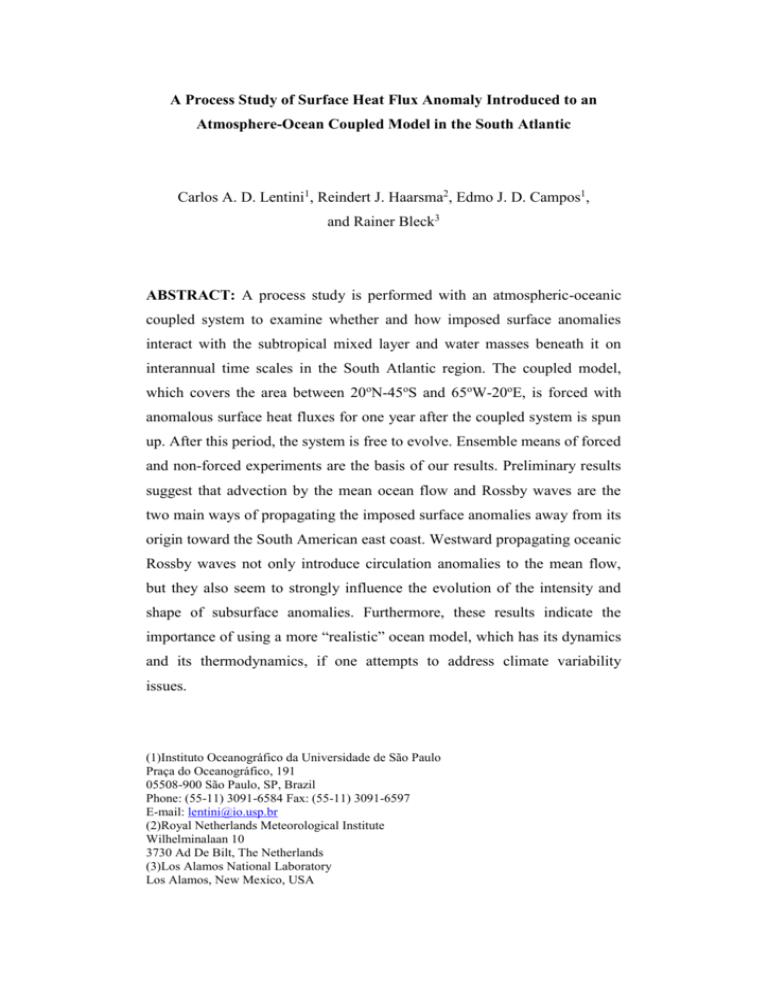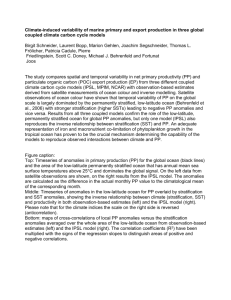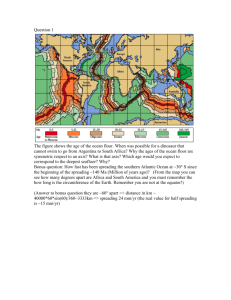The surface heat flux anomaly experiment
advertisement

A Process Study of Surface Heat Flux Anomaly Introduced to an Atmosphere-Ocean Coupled Model in the South Atlantic Carlos A. D. Lentini1, Reindert J. Haarsma2, Edmo J. D. Campos1, and Rainer Bleck3 ABSTRACT: A process study is performed with an atmospheric-oceanic coupled system to examine whether and how imposed surface anomalies interact with the subtropical mixed layer and water masses beneath it on interannual time scales in the South Atlantic region. The coupled model, which covers the area between 20oN-45oS and 65oW-20oE, is forced with anomalous surface heat fluxes for one year after the coupled system is spun up. After this period, the system is free to evolve. Ensemble means of forced and non-forced experiments are the basis of our results. Preliminary results suggest that advection by the mean ocean flow and Rossby waves are the two main ways of propagating the imposed surface anomalies away from its origin toward the South American east coast. Westward propagating oceanic Rossby waves not only introduce circulation anomalies to the mean flow, but they also seem to strongly influence the evolution of the intensity and shape of subsurface anomalies. Furthermore, these results indicate the importance of using a more “realistic” ocean model, which has its dynamics and its thermodynamics, if one attempts to address climate variability issues. (1)Instituto Oceanográfico da Universidade de São Paulo Praça do Oceanográfico, 191 05508-900 São Paulo, SP, Brazil Phone: (55-11) 3091-6584 Fax: (55-11) 3091-6597 E-mail: lentini@io.usp.br (2)Royal Netherlands Meteorological Institute Wilhelminalaan 10 3730 Ad De Bilt, The Netherlands (3)Los Alamos National Laboratory Los Alamos, New Mexico, USA RESUMO: Um estudo de caso é executado com um sistema acoplado atmosférico-oceânico para examinar de que forma e como anomalias superficiais impostas interagem com a camada mistura subtropical e massas de água abaixo dela em escalas inter-anuais na região do Atlântico Sul. O modelo acoplado, que cobre a área entre 20oN-45oS e 65oW-20oE, é forçado com fluxos anômalos de calor na superfície durante um ano depois que o sistema acoplado atinge seu equilíbrio. Após este período o sistema é livre para evoluir. Um conjunto de experimentos com forçante e sem forçante é a base de nossos resultados. Os resultados preliminares sugerem que a advecção pelo fluxo oceânico médio e ondas de Rossby são os dois modos principais de propagar as anomalias geradas na superfície, impostas longe de sua origem para a costa leste Sul-Americana. Ondas de Rossby oceânicas propagando para oeste não só apresentam anomalias na circulação do fluxo médio, mas elas também parecem influenciar a evolução da intensidade e forma das anomalias de sub-superfície fortemente. Além disso, estes resultados indicam a importância de usar um modelo oceânico mais “realístico”, que tem sua dinâmica e termodinâmica presentes, tem que ser empregado se assuntos ligados à variabilidade do clima forem enfocados. Keywords: South Atlantic Dipole, SPEEDY, MICOM, coupled system, Rossby waves, advection, subtropical ocean gyre. INTRODUCTION Air-sea coupling in mid-latitudes has received more attention lately due to global climate variability issues. Particularly, a lot of scientific effort has been put on practice to understand the physical mechanisms behind the ocean-atmosphere coupling and the link between sub-tropical and tropical regions (e.g., Gu and Philander, 1997; Lysne et al., 1997; Murtugudde et al., 1996; Stramma and England, 1999). Barnett et al. (1999) identified two main unresolved questions on the ocean-atmosphere coupling in mid-latitudes: (i) what is the direct impact of mid-latitude upper ocean anomalies on atmospheric variability? (ii) is there a feedback between the ocean and atmosphere that allows the existence of low-frequency oscillatory modes? If the low-frequency climate change results from a two-way interactive process between these two fluids that involve a delay due to the high inertia of the ocean (Latif and Barnett, 1996), then the process is potentially predictable if its hydrodynamics is understood. On the other hand, if the ocean integrates random atmospheric forcing (Barsugli and Battisti, 1998) without significant feedback to the atmosphere, the benefit of climate modeling for long-lead forecasts is marginal at best. To answer the question of how mid-latitude ocean anomalies impact the atmospheric variability and vice-versa, modeling studies are often used. The motivation for numerical simulations can be explained by the difficulty of separating “cause and effect” from observational data alone, since the ocean-atmosphere system is intrinsically coupled. The way in which ocean surface anomalies can be imposed in a process study is via prescribed sea surface temperatures or heat flux anomalies. However, the intensity, shape, and duration of such imposed forcing is extremely important as these anomalies may affect the coupled system differently. Therefore, an isopycnal coordinate ocean model coupled to an atmosphere model has been used to investigate the response of this coupled system forced with anomalous heat fluxes in the form of the South Atlantic Dipole (Sterl and Hazeleger, 2003) on interannual time scales. The main focus of this study is to understand how the ocean responds to such a forcing on these time scales. This paper is outlined as follows: a short introduction of the atmospheric and oceanic models used in the coupled system simulations; the model spin-up and the forcing set-up description; the results of the ocean component are presented and discussed followed then by concluding remarks. THE COUPLED SYSTEM Atmospheric model The atmosphere global model used in this study is SPEEDY (Molteni, 2003). It is an intermediate complexity model based on a spectral primitiveequation core and a set of simplified parameterization schemes. The parameterization package has been especially designed to work in models with just a few vertical levels, and is based on the same physical principles adopted in the schemes of state-of-the-art AGCMs. The parameterized processes include large-scale condensation, convection, clouds, short and long wave radiation, turbulent surface fluxes and vertical diffusion. The horizontal resolution is T30 and it has 7 vertical levels. It is at least an order of magnitude faster than a state-of-the-art AGCM. The quality of the simulated climate compares well with that of more complex AGCMs. Some aspects of the systematic errors of SPEEDY are in fact typical of many AGCMs, although the error amplitude is higher than in those models. Ocean model The ocean model used in this study is the Miami Isopycnal Coordinate Ocean Model (MICOM) (Bleck et al., 1992) in a regional configuration. The basin is confined to the South and Tropical Atlantic from 45oS to 20oN. Outside this basin the boundary condition for the atmospheric model is a passive mixed layer which will be briefly described below. Apart from the reduction in computing time an advantage of a basin configuration is that the mechanism of air-sea interaction over the Atlantic can be isolated from other processes like the influence of Pacific SST anomalies on the atmospheric circulation over the Atlantic. The resolution is 1 degree in the horizontal direction and 16 vertical layers. Outside the oceanic domain of interest, the boundary condition for the atmospheric model is a “slab ocean”. In this model the ocean is represented by a passive mixed layer for which the temperature of the mixed layer “T” is given by, T Q Fm t h w c p where: Q is the net surface heat flux leaving the ocean, h is the mixed layer depth, w the sea water density, cp the specific heat capacity of sea water, and Fm represents the induced heat transport by the ocean and all other processes neglected in this balance. To ensure that the climatology of the mixed layer model stays close to the observed climatology, Fm is diagnosed from the above equation in a run with SPEEDY in which “T” is prescribed as, Fm Tc lim Qdiag t h w c p where: Tclim is the daily mean observed climatological SST computed by linear interpolation from the climatological monthly mean SST of Da Silva et al. (1994), and Qdiag is the daily diagnosed net surface heat flux from the model. Qdiag represents the ocean heat transport which can not be simulated in the slab model. Fm computed by the above equation varies in space and goes through an annual cycle. MODEL SPIN-UP AND FORCING SET-UP The surface heat flux anomaly experiment The coupled model is integrated for 40 years. SPEEDY-MICOM is spun up from the Levitus climatology for the first 20 years before the atmospheric anomalous forcing is introduced. Haarsma et al (2003) show that the main heat source for generating SST anomalies in the area of interest is the latent heat flux (LHF), whereas the sensible heat flux (SHF) and radiation terms are less important. Therefore, the ocean model is forced by LHF anomalies imposed by the atmosphere which have the same spatial pattern of the South Atlantic dipole (Sterl and Hazeleger, 2003). This dipole-like structure is obtained from a SVD analysis of MSLP and SST in the SPEEDY-MICOM coupled model without any forcing during a 60-yr integration (Haarsma et al, 2003) which is very similar to the one obtained by Sterl and Hazeleger (2003) from the NCEP-NCAR Reanalysis data (Figure 1). The choice of forcing the ocean model with this particular pattern is two-fold: (i) it is a consistent feature in the coupled system and has been observed both on data and model output analyses, and (ii) LHF anomalies is one of the main processes leading to the observed SST variability in the South Atlantic (Sterl and Hazeleger, 2003; Haarsma et al, 2003). In order to have robust results and to decrease the model's internal variability, a set of identical experiments was done with slight different initial conditions. Therefore, two sets of experiments were done: with and without forcing. The coupled system is forced then by this dipole for one year as the focus of this research is the interannual variability response of imposed surface anomalies (Figure 2). After this 1 year, no forcing is added and the coupled system is free to evolve for the following 19 years. Ensemble mean of the non-forced experiment (hereafter, Control) is compared to an ensemble mean of the forced experiment (hereafter, Forced). Seasonal mean outputs are the basis of all subsequent analyses. Figure 1: First SVD mode between sea-level pressure (SLP) and sea surface temperatures (SST) computed from SPEEDY-MICOM (Haarsma et al., 2003, top panel) and from NCEP-REANALYSIS (Sterl and Hazeleger, 2003, bottom panel) which each one explains 33% and 38% of the total variability, respectively. Figure 2: The anomalous surface latent heat fluxes introduced to the coupled system after the 20 years of spin up. The coupled system is forced during one year. After that, the system is free to evolve. RESULTS The stream-function of the barotropic velocity (BT-Vel, contours) of the control experiment superimposed on the sea surface height (SSH, colors) averaged over the last 20 years after the spin-up captures well the mean general circulation of the South Atlantic ocean (Figure 3). The asymmetric dipole-like surface latent heat flux anomalies imposed during year 21 generate cool SST anomalies (SSTAs) in the northern part of the dipole and warm SSTAs in the southern part, respectively (Figure 4). Intensification of negative SSTAs takes place from austral summer (JFM) to austral fall (AMJ) reaching values of –1.2oC, and then decrease during the following season. However, it is during austral spring (OND) that negative SSTAs expand from 30oS toward the equator, increase their magnitude, and reach a minimum of -1.2 to -1.5oC roughly centered at 20oS and 10oW. Warm SSTAs observed in the southern part of the domain show a more seasonal dependence, reaching positive values during summer and spring seasons. Both warm and cool SSTAs basically disappear in the following year (not shown) after the atmospheric surface forcing is turned off and the coupled model is free to evolve. Beneath the ocean’s surface, the results show a relatively significant increase of the intensity of the anomalies with time and their rapid and large vertical extension. During year 21 the northern part of the dipole, which is associated with cool SSTAs, subducts trough Ekman pumping and, at the end of the forced year, the resulting subsurface anomaly reaches its maximum value of + 0.9°C and extends from 200-m to 600-m deep (Figure 4). Although the occurrence of positive subsurface temperature anomalies may sound counter-intuitive at this point, one has to notice that these subducted anomalies have slightly higher temperatures than its surroundings; therefore they appear as positive anomalies instead of cool anomalies. After year 21, horizontal maps of layer thickness anomaly referenced to the 600-m depth level for the following first 8 years show that the subducted perturbation moves toward the South American east coast with a mean velocity of ~4cm/s, a value very close to the intensity of the mean South Atlantic subtropical gyre circulation. However, the displacement of the perturbation indicates that there is an undulatory phenomenon at play. First, the increase in intensity of the subducted anomaly core resembles an amplitude increase of a wave signal through interaction between different vertical modes (Liu, 1999). Second, the rapid and considerable vertical extension of this anomaly as well as its extension to a deeper isopycnal layer is suggestive of downward wave propagation indeed. One can clearly observe the subducted perturbation of the mean flow propagating westward from its initial location in the interior of the ocean basin around the 25o of latitude which is interpreted as a first mode baroclinic Rossby wave. Velocity estimates are in agreement with observational computations of phase speed of oceanic Rossby waves around this latitude for the South Atlantic (Paulo S. Polito, 2004, pers. comm.). From years 26 to 28, the anomaly core follows the Brazilian coast and moves poleward. Figure 3: MICOM control output averaged over the last 20 years after the spin-up time in the coupled system for the area of study. Figure 4: Vertical profile of the temperature difference between Forced and Control runs for the four seasons when the forcing is introduced to the coupled system. The green lines represent the layer thickness of the control run. Figure 5: 8-year time evolution of the layer thickness anomaly (Forced – Control runs, in meters) referenced to the 600-m level. Positive layer thickness anomaly values are reddish, whereas negative values are bluish. CONCLUDING REMARKS A process study is performed with an atmosphere-ocean coupled model to examine how imposed surface heat flux anomalies interact with the subtropical mixed layer and water masses beneath it on interannual time scales in the South Atlantic region. The trajectory and speed of the subducted perturbation is in agreement with the mean flow to a first approximation, a result consistent with previous observational studies in the Atlantic (Stramma and England, 1999). Our results indicate that a combination of mean subtropical flow advection and Rossby wave dynamics are the two main ways of propagating the imposed anomalies across the ocean basin. Moreover, a relatively significant increase of the intensity of the subducted anomalies with time and their rapid and large vertical extension as a consequence of Ekman pumping and air-sea interaction is observed. For instance, cooling by latent heat flux anomalies creates warm subsurface temperature anomalies due to an increase in salinity anomaly at the surface. The westward propagation of the induced perturbation is associated with a salinity-compensation phenomenon that strongly balances the temperature-related density perturbation. The propagation of this perturbation does not seem to be related to air-sea interaction but to oceanic adjustment in the perturbed subsurface density field. Acknowledgments: This work has been funded by IAI (SACC-CRN 060), FAPESP (grants 01/10965-6 and 04/01849-0). REFERENCES Barnett, T. P., D. W. Pierce, M. Latif, D. Dommenget, and R. Saravanan, Interdecadal interactions between the tropics and midlatitudes in the Pacific basin. Geophys. Res. Lett., 26, 615-618, 1999. Barsugli, J. J. and D. S. Battisti, The basic effects of atmosphere-ocean thermal coupling on midlatitude variability. J. Atmos. Sci., 55, 477-493, 1998. Gu, D. F. and S. G. H. Philander, Interdecadal Climate fluctuations that depend on exchanges between the tropics and extratropics. Science, 275, 805-807, 1997. Haarsma, R. J., E. J. D. Campos, and F. Molteni, Atmospheric response to South Atlantic SST Dipole. Geophys. Res. Lett., doi: 10.1029/2003 GL017829, 2003. Latif, M. and T. P. Barnett, Decadal climate variability over the North Pacific and North America: Dynamics and predictability. J. Climate, 7, 2407-2423, 1996. Liu, Z., Planetary wave modes in the thermocline: Non-Doppler-shift mode, advective mode and Green mode. Quat. J. Royal Meteor.Soe., 125, 13151339, 1999. Lysne J., P. Chang and B. Giese, Impact of the extratropical Pacific on equatorial variability. Geophys. Res. Lett., 24, 2589-2592, 1997. Molteni, F., Atmospheric simulations using a GCM with simplified physical parameterizations. I: Model climatology and variability in multi-decadal experiments. Clim. Dyn., 20, doi:10.1007/s00382-002-0268-2, 2003. Murtugudde, R., R. Seager and A. Busalacchi, Simulation of the tropical oceans with an ocean GCM coupled to an atmospheric mixed layer. J Clim., 9, 1795-1815, 1996. Sterl, A. and W. Hazeleger, Coupled variability and air-sea interaction in teh South Atlantic. Clim. Dyn., 21, 559-571, 2003. Stramma, L. and M. England, In the water masses and mean circulation of the South Atlantic Oceano J Geophys Res., 104, 20863-20883, 1999.







